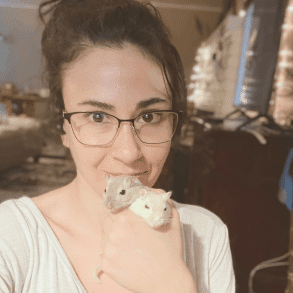Classroom pets have been common in many educational settings for years. Unfortunately, the practice of keeping small pets in classrooms is typically very inhumane and detrimental to the pet’s health and well-being. It also isn’t always the best choice for the children’s well-being or the learning environment in general, either.
- 1. Classrooms Aren’t the Ideal Space for a Small Pet
- 2. It’s Hard to Meet a Pet’s Essential Needs in a Classroom
- 3. Classroom Pets Typically Aren’t Ethically Sourced
- 4. Classroom Pets Can Cause Anxiety and Guilt in Children
- 5. Classroom Pets Can Teach Improper Animal Treatment
- 6. Most Small Pets Sleep During the Day
- 7. Keeping Small Pets Requires a Discussion About Death
- 8. Small Pets Can Be a Distraction
- 9. Small Pets Can Cause Health Issues in Children
- 10. Other Methods Can Achieve the Same Results
This article will explore the reasons why small pets should not be kept in classrooms, and why educators and parents should look for alternative ways to teach children about animals and their care.
1. Classrooms Aren’t the Ideal Space for a Small Pet
It’s understandable that teachers and students alike might think it’s fun and educational to keep small animals like hamsters, gerbils, mice, and guinea pigs in the classroom as “classroom pets.” Unfortunately, this is usually an unethical practice, as it can be incredibly harmful to the animal.
One of the reasons it’s harmful to a small pet is that the classroom itself doesn’t offer the right conditions for a small rodent. Below are some examples of why this is the case.
Noise and activity levels
Small animals are sensitive creatures, and they need to live in an environment that offers them peace and quiet. Keeping them in a classroom, with all of its activity and disruption, can create an extremely stressful atmosphere that is highly detrimental to their mental and physical well-being.
Unsuitable enclosures
Classroom pets are typically kept in small, unsuitable enclosures in order to save space. A proper small pet enclosure would usually take up more space than the school has available in an already crowded classroom.
Temperature and humidity levels
Furthermore, the temperature and humidity levels in a classroom are usually not optimal for these small animals, making them even more vulnerable to suffering.
In short, classrooms are not suitable for small pets, and keeping them there is not only unnecessary but also cruel and inhumane.
Learn more: Hamster Cage Size Minimums Around the World
2. It’s Hard to Meet a Pet’s Essential Needs in a Classroom
In addition to the environment a small pet is living in, they also have other needs that are difficult to meet when the pet is a classroom pet. Here are some examples.
Correct food and enrichment
Feeding and entertaining a small pet might not seem difficult or expensive at first–that is until you look into the type of nutrition and enrichment small animals really need.
Meeting a small pet’s nutritional needs and its need for the proper enrichment items costs money, which is something that school systems are rarely able to spare.
Medical care
Just because a pet is small doesn’t mean it doesn’t deserve veterinary care just like a cat or dog would. A school is less likely to make sure a small animal is getting the medical attention it needs if it becomes sick, which means that the animal isn’t receiving ethical care.
Solitary living
Additionally, small pets in classrooms are typically kept solitary to save on space and costs. Most small animals are social (other than hamsters), so this is extremely detrimental to their health and happiness.
Unstable human bonds
The pet also suffers because it can’t build a lasting relationship with a stable pet parent. These bonds are important for many small pets, especially those who are solitary, like a hamster.
The practice of taking home the pet for the weekend or over holidays also means the pet is changing environments regularly, which typically causes immense stress for a small mammal.
3. Classroom Pets Typically Aren’t Ethically Sourced
One of the serious issues with keeping small pets in classrooms is that they typically aren’t sourced from ethical breeders or animal rescues. Instead, these animals are often purchased at pet stores, which contributes to harmful breeding practices, inhumane treatment of pets, and unhealthy living conditions.
This means that the classroom pet could potentially come from a store where animals are raised in overcrowded and unsanitary cages, or with parents that were bred multiple times until they become too weak to reproduce, resulting in serious health and welfare issues for the animals.
Further, pet stores often do not require proof of vaccinations or health records for the animals they sell, making it difficult for anyone to know if the pet has been adequately cared for. Unfortunately, this means that the classroom pet may have underlying medical issues or even diseases that can put children at risk.
While some people may think that purchasing small pets from pet stores is an easy way to get an affordable animal for their classroom, it is important to remember that these animals are living creatures, not objects, and they deserve to be treated humanely.
By purchasing a pet from a pet store, we are essentially supporting an industry that exploits animals for profit and can lead to serious health issues for both the animal and the children in the classroom.
4. Classroom Pets Can Cause Anxiety and Guilt in Children
Having a classroom pet can cause anxiety and guilt in children. Students may feel anxious about their responsibility for the pet’s care and the ethical treatment of the animal. It is important for teachers to recognize the potential for anxiety related to caring for a pet.
In addition, some students may feel guilty about how the pet is being treated. If the class is not engaging in the ethical treatment of the animal, such as providing it with proper nutrition, housing, and medical care, or if the class is engaging in activities that are potentially damaging or harmful, then this could lead to feelings of guilt.
Furthermore, if the class is not regularly engaged with the pet, it could lead to feelings of neglect or abandonment that could create distress in some students.
5. Classroom Pets Can Teach Improper Animal Treatment
When a small pet is kept in the classroom, students are often exposed to incorrect or incomplete information about how to properly care for animals. Not only can this lead to the mistreatment of that particular classroom pet, but it can lead children to mistreat other animals later in life.
Unfortunately, these poor teaching practices can stay with a person into adulthood and lead to the mistreatment of their own pets or other animals they come into contact with.
6. Most Small Pets Sleep During the Day
Small pets, such as hamsters, rabbits, and mice, are nocturnal or crepuscular animals. This means that they sleep during the day and are most active at night or at dawn and dusk. While this may not seem like a big deal, it can be an issue in classrooms.
Having an animal that is sleeping during the day is not beneficial to children as they will rarely be able to interact with it. Furthermore, waking a sleeping animal can be extremely stressful and distressing to the pet. This goes against the humane treatment of animals and is something that should not be done in classrooms.
7. Keeping Small Pets Requires a Discussion About Death
Death is a difficult topic for adults, let alone children. When a classroom pet with a short lifespan is brought in, there is a high likelihood that at some point during the year, the pet will pass away. Unfortunately, this death can be very traumatic for young students who may not be familiar with the idea of death or understand its finality.
Teachers should also be aware that many parents may not be ready to introduce the concept of death to their children, and they would likely prefer to discuss it with them privately at home. If a pet dies in class, it may become difficult for the teacher to address the situation without upsetting the students and their parents.
8. Small Pets Can Be a Distraction
Having small pets in the classroom can be a major distraction for students. Pets can move around, make noise, and generally cause disruption during class.
This can be especially problematic when the teacher is trying to give an important lesson and does not want the lesson disrupted. The presence of small pets can make it difficult for students to focus on their studies and may lead to decreased learning outcomes.
9. Small Pets Can Cause Health Issues in Children
Small pets, such as hamsters, gerbils, and other rodents, can cause health issues in children if they are not handled with the proper sanitary precautions. These small animals can carry parasites and illnesses that can sometimes spread to children.
If a child is not careful, they can pick up germs and pathogens from handling the pet or from their bedding or cage. Additionally, some children may be allergic to the pet or their food and bedding, which can cause skin rashes and respiratory issues. Some common allergens include fur, dander, and urine from the pet.
To ensure that children do not come in contact with any of these potential hazards, it is important for them to wash their hands before and after handling the pet. This is not always easy for young children to remember, and it can take away valuable class time.
10. Other Methods Can Achieve the Same Results
Instead of using small pets in classrooms, there are many alternatives that teachers can use to teach students about responsibility, pet care, animal science, and more.
Some examples are:
- Inviting guest speakers from animal shelters, rescues, sanctuaries, or veterinary clinics to talk about their work and how to help animals.
- Organizing field trips to visit local animal facilities or wildlife habitats and observe animals in their natural settings.
- Using books, videos, games, models, or simulations to learn about different animal species and their behaviors.
- Adopting an animal virtually through online platforms or organizations that support animal welfare.
- Encouraging students to volunteer at animal shelters or rescues or foster an animal at home with parental consent and involvement.
Conclusion: Keeping Small Pets in Classrooms is a Bad Idea
When it comes to keeping small pets in classrooms, the risks far outweigh the rewards. Small pets kept in classrooms can suffer from a variety of ailments and improper care, which can lead to their premature death.
Additionally, students can develop anxiety and guilt from the responsibility of taking care of the pet, and they can be more predisposed to animal cruelty if taught improper animal care techniques. The distraction that small pets create in a classroom environment can also affect student performance, and small pets can negatively affect some children’s health.
There are many other methods available to teach children about animals and caretaking that do not involve actually bringing animals into the classroom. From virtual programs to educational videos, there are plenty of ways to engage students without putting a pet in an environment where they are likely to suffer and be neglected.
Keeping small pets in classrooms is not a responsible decision and should be avoided in order to ensure their safety and well-being.








0 Comments